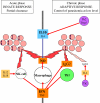Babesia and its hosts: adaptation to long-lasting interactions as a way to achieve efficient transmission
- PMID: 19379662
- PMCID: PMC2695028
- DOI: 10.1051/vetres/2009020
Babesia and its hosts: adaptation to long-lasting interactions as a way to achieve efficient transmission
Abstract
Babesia, the causal agent of babesiosis, are tick-borne apicomplexan protozoa. True babesiae (Babesia genus sensu stricto) are biologically characterized by direct development in erythrocytes and by transovarial transmission in the tick. A large number of true Babesia species have been described in various vertebrate and tick hosts. This review presents the genus then discusses specific adaptations of Babesia spp. to their hosts to achieve efficient transmission. The main adaptations lead to long-lasting interactions which result in the induction of two reservoirs: in the vertebrate host during low long-term parasitemia and throughout the life cycle of the tick host as a result of transovarial and transstadial transmission. The molecular bases of these adaptations in vertebrate hosts are partially known but few of the tick-host interaction mechanisms have been elucidated.
Figures


References
-
- Adachi K., Ueno C., Makimura S.. Immunosuppression in dogs naturally infected with Babesia gibsoni. J. Vet. Med. Sci. 1993;55:503–505. - PubMed
-
- Allred D.R., Carlton J.M., Satcher R.L., Long J.A., Brown W.C., Patterson P.E.. et al. The ves multigene family of B. bovis encodes components of rapid antigenic variation at the infected erythrocyte surface. Mol. Cell. 2000;5:153–162. - PubMed
-
- Allred D.R.. Molecular technology and antigenic variation among intraerythrocytic hemoparasites: do we see reality? Vet. Parasitol. 2001;101:261–274. - PubMed
-
- Allred D.R., Al-Khedery B.. Antigenic variation as an exploitable weakness of babesial parasites. Vet. Parasitol. 2006;138:50–60. - PubMed
Publication types
MeSH terms
LinkOut - more resources
Full Text Sources
Miscellaneous
